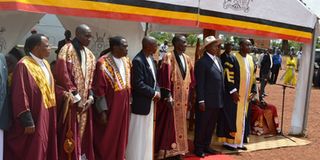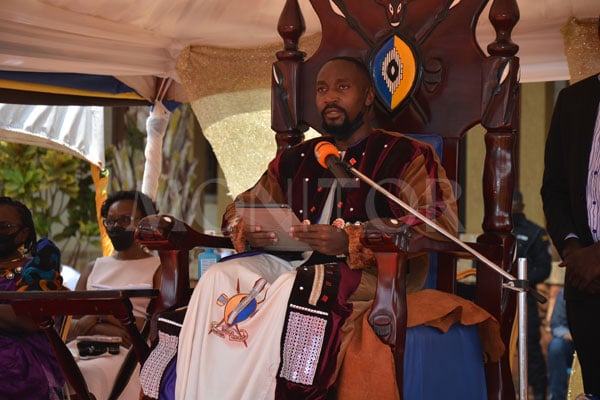Prime
How Nadiope defeated Wambuzi to stay king

President Museveni (2nd right), Kyabazinga William Gabula Nadiope (right) and some Busoga royal chiefs grace Gabula Day celebrations at Budhumbula palace in Kamuli District in 2012. PHOTO/FILE
What you need to know:
- In 2014, President Museveni and the then Speaker of Parliament, Ms Rebecca Kadaga, asked the royal chiefs to elect a substantive Kyabazinga.
After losing the 2014 Kyabazinga election, Prince Edward Columbus Wambuzi decided to run to court with hope of overturning the win of William Gabula Nadiope.
Mr Wambuzi filed the petition at the High Court in Jinja District, accusing Kyabazinga Nadiope of being elected in disregard of the kingdom constitution.
He stated that Article 6 of the kingdom constitution requires that the election of a new Kyabazinga be conducted upon the death of substantive Kyabazinga, and in this case, there was no need for the election because he (Wambuzi) was a serving Kyabazinga after being elected on October 31, 2008 upon the death of his father Henry Wako Muloki.
However, the Nadiope group contested the election on grounds that there was no quorum of eight royal chiefs out of the 11 hereditary chiefs entrusted with electing a Kyabazinga as enshrined in Article 8 of the Busoga constitution.
The group also organised a fresh election in 2009, in which Nadiope was elected the Kyabazinga.
However, the Wambuzi group also contested his election, claiming he had no quorum because only five royal chiefs elected him.
Mr Wambuzi, with support of the then Busoga prime minister Wilson Muwereza, remained king amid fights between the supporters of the two factions.
However, in 2014, President Museveni and the then Speaker of Parliament, Ms Rebecca Kadaga, asked the royal chiefs to elect a substantive Kyabazinga.
But Mr Wambuzi opposed the move, saying there had already been an election, but the royal chiefs on August 23, 2014, in an impromptu meeting, resolved to turn into a council of royal chiefs and elected Nadiope as substantive Kyabazinga.
Mr Wambuzi sought a court injunction to block the move, and the case dragged on until last Friday when the deputy registrar at Jinja High Court, Mr Fred Waninda, read the judgment of Justice Jeanne Rwakakooko.
In her judgment, Justice Rwakakooko held that the election for both Wambuzi and Nadiope in 2008 and 2009, respectively, lacked quorum.

Prince Edward Columbus Wambuzi
Based on the irregularities in the Wambuzi and Nadiope pre-2014 election, the court resolved that there was no substantive Kyabazinga during that period.
“The election of Wambuzi on October 31, 2008 was null and void because it lacked quorum. Article 8 of the Busoga constitution, requires at least eight members out of the eleven hereditary royal chiefs to be present during the elections but during Wambuzi’s election, only seven hereditary chiefs were in attendance and three moved out of the election hall hence contradicting that law,” Justice Rwakakooko ruled.
She also ruled that the election of Nadiope in 2014 was in line with article 8 of the constitution because there was a quorum of eight people.
“Following resolution of this case in favour of the Nadiope, this suit is hereby accordingly dismissed,’’ the judge ruled.
Court directed that Mr Wambuzi cater for suit costs of each party.
What next
Mr Edward Wambuzi’s lawyer, Mr Daniel Lubogo, said they would return to the clan heads. “We shall seek consultation from the head of the clans, and people of Busoga and then we shall make direction on what next,” he said, adding that the judgment came at a time when the chiefs that elected Nadiope had rejected him. “Our understanding is that it will not be practical for Nadiope to continue presiding over Busoga yet the chiefs are saying he is not their Kyabazinga,” he said. A section of royal chiefs signed a petition passing a vote-of-no confidence in Nadiope and confirmed Wambuzi as their substantive Kyabazinga. The Gabula group responded by unseating all the rebel royal chiefs and substituted them with new ones.
READ MORE




